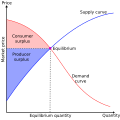Talk:Cycle of poverty
| This is the talk page for discussing improvements to the Cycle of poverty article. This is not a forum for general discussion of the article's subject. |
Article policies
|
| Find sources: Google (books · news · scholar · free images · WP refs) · FENS · JSTOR · TWL |
| Archives: 1Auto-archiving period: 2 years |
| This article is rated Start-class on Wikipedia's content assessment scale. It is of interest to the following WikiProjects: | |||||||||||||||||||||
| |||||||||||||||||||||
Wiki Education assignment: LLIB 1115 - Intro to Information Research
[edit]![]() This article was the subject of a Wiki Education Foundation-supported course assignment, between 11 January 2022 and 6 May 2022. Further details are available on the course page. Student editor(s): ParrTiff (article contribs).
This article was the subject of a Wiki Education Foundation-supported course assignment, between 11 January 2022 and 6 May 2022. Further details are available on the course page. Student editor(s): ParrTiff (article contribs).
Single parent
[edit]I also would like to see more substantial discussion of a single parent. Fatherless familes are more likely to force children into extremel poverty. AXONOV (talk) ⚑ 09:35, 2 January 2024 (UTC)
minimum wage graph
[edit]Thinking of removing the minimum wage graph under Economic Factors since it has no apparent connection to any text in this article. Uhoj (talk) 13:37, 22 May 2025 (UTC)
- @Uhoj: You removed the connection I added after your comment above. See diff. And see version:
- https://en.wikipedia.org/w/index.php?title=Cycle_of_poverty&oldid=1292151893
- Here is what was there that you removed (except for the poverty map which I added at the same time):
|
Economic factors (section heading)    Many people in poverty in the US are in households with some people working at minimum or low wages. The US federal minimum wage has not kept up with inflation. It peaked in 1968 in inflation-adjusted dollars.[3] So it is more and more difficult for those households to get out of poverty. Especially in states that haven't raised the minimum wage very much, or at all, beyond the current federal minimum wage of $7.25 an hour. See chart and maps to the right. Oftentimes some people in those households can not work much, or at all, for various reasons. See next paragraph. References
|
What is not clear about it?
At the same time I added the persistent poverty map to the intro:

References
- ^ "Census Bureau Releases New Report About Persistent Poverty at County and Census-Tract Level". Census.gov. US Census Bureau. May 9, 2023.
Here is the diff for all my work done after your initial comment in this thread. --Timeshifter (talk) 12:44, 26 May 2025 (UTC)
- @Timeshifter Yes I saw that graphics and text were added. Thank you for taking the time to do this. I kept the parts directly related to poverty, but removed the stuff about minimum wage. That's because the connection between minimum wage and poverty lies somewhere between original research and improper synthesis. If there is a connection please describe it with text and graphics that are backed by reliable sources that explicitly make the connection. Uhoj (talk) 13:25, 26 May 2025 (UTC)
- The connection is obvious, and is made by plenty of reliable sources on the web. I will let others fill in the connections with some prose and references. Maybe you and others can do that. I will stick to finding and creating maps and charts. That is plenty of work for me. --Timeshifter (talk) 13:35, 26 May 2025 (UTC)
Uhoj. OK. I found some time to find some good references. I added the graphs and paragraph back to the article, along with the references:
References
- ^ Yarrow, Andrew (April 7, 2015). "How low wages hurt families and perpetuate poverty". Oxfam America.
- ^ Ross, Kyle (24 July 2024). "The Minimum Wage Is a Poverty Wage". Center for American Progress.
- ^ "The Effects of a $15/Hour Federal Minimum Wage on Poverty, Earnings, and Net Family Resources". Robert Wood Johnson Foundation. The full report is dated September 2022.
--Timeshifter (talk) 06:09, 28 May 2025 (UTC)
- @Uhoj: I appreciate the thanks you gave me.
- Adam8410 found some more references, both pro and con, concerning raising the minimum wage. Though he removed a couple of my references listed above. I returned them.
- Here are some more pro references I found and added:[1][2]
References
- ^ Openchowski, Emilie (16 October 2023). "New research finds $15 minimum wages raise pay and increase employment for low-wage workers". Washington Center for Equitable Growth.
- ^ José Azar , Emiliano Huet-Vaughn , Ioana Marinescu , Bledi Taska , Till von Wachter "Minimum Wage Employment Effects and Labour Market Concentration". The Review of Economic Studies. 91 (4): 1843–1883. September 8, 2023.


